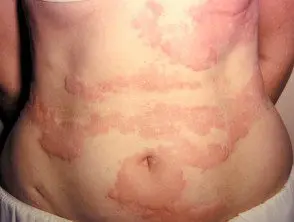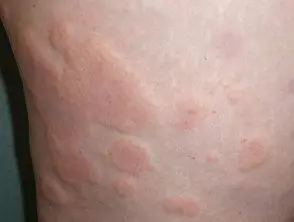What is it urticaria?
Urticaria is a skin condition characterized by cure (urticaria) or angioedema (swellings, in 10%) or both (in 40%). There are several types of hives.
- The name urticaria is derived from the common European nettle. Urtica dioica.
- A bump (or bump) is a superficial swelling of pale or skin color, usually surrounded by erythema (redness) that lasts from a few minutes to 24 hours. Usually itchy, may have a burning sensation.
-
Angioedema is a deeper swelling inside the skin or mucous membranes and can be skin colored or red. It resolves in 72 hours. Angioedema can cause itching or pain but is often asymptomatic.
What is it chronic urticaria?
Chronic urticaria is hives in which there is daily or episodic scarring or angioedema that is present for more than six weeks. Chronic urticaria can be spontaneous or inducible. Both types can coexist.
Inducible or physical urticaria is classified according to the stimulus that causes healing.
- Symptomatic dermographism
- Cold urticaria
- Cholinergic urticaria
- Contact urticaria
- Delayed pressure urticaria
- Solar urticaria
- Heat urticaria
- Vibratory urticaria
- Aquagenic urticaria
Chronic urticaria

Symptomatic dermographism

Spontaneous urticaria

Spontaneous urticaria
See more hives images.
Who gets chronic hives?
Chronic spontaneous urticaria affects 0.5-2% of the population; in some series, two-thirds are women. Inducible urticaria is more common than chronic spontaneous urticaria. exist genetic and autoimmune associations.
What are the clinical characteristics of chronic urticaria?
Hives are characterized by richness.
- Scars can affect any site on the body and tend to be widely distributed.
- Cracks can be a few millimeters or several centimeters in diameter.
- They can be white or red, with or without a red flare.
- Each healing may last a few minutes or several hours and may change shape before resolving.
- Scars can be round, or form rings, a map-like pattern, or giant patches.
Angioedema is more common. located.
- It commonly affects the face (especially presenting as swollen eyelids and lips), hands, feet and genitals.
- May involve tongue, uvula, soft palate, and larynx.
In chronic inducible urticaria, scars appear approximately 5 minutes after the stimulus and last a few minutes or up to an hour. Characteristically, the riches are:
- Linear in symptomatic dermographism
- Tiny in cholinergic urticaria
- Confined to contact areas in contact urticaria
- Diffuse in cold hives: if large areas of skin are affected, it can cause fainting (potentially dangerous if swimming in cold water).
The scars are more persistent in chronic spontaneous urticaria, but each one has disappeared or changed shape within 24 hours. They can occur at certain times of the day.
Evaluation of the severity of urticaria.
Visual analog term The scales can be used to record and compare the degree of itch.
Chronic urticaria activity can be assessed using the UAS7 scoring system. Daily healing/itch scores are added over seven days; The maximum score is 42.
Score 0
- There are no healings for 24 hours.
- No itching
Score 1
- <20 curas durante 24 horas
- mild itching
Score 2
- 20 to 50 cures during 24 hours
- moderate itching
Score 3
- > 50 cures for 24 hours
- intense itching
The emotional impact of urticaria and its effect on quality of life should also be evaluated. the Dermatology Quality of life index (DLQI) and CU-Q2OL, a chronic urticaria-specific questionnaire, has been validated for chronic urticaria, where sleep disruption is a particular problem.
Systemic symptoms in chronic spontaneous urticaria
Some patients with chronic spontaneous urticaria report several associated systemic symptoms. These include:
- Headache and fatigue
- Joint pain or inflammation.
- Wheezing, redness and palpitations.
- Gastrointestinal symptoms.
What causes chronic hives?
The scars are due to the release of chemical mediators from the tissue. mast cells and circulating basophils. These chemical mediators include histamine, plateletactivation factor and cytokines. Mediators activate the sensory nerves and cause dilation of blood vessels and fluid leakage into the surrounding tissues. The release of bradykinin causes angioedema.
Several hypotheses have been proposed to explain urticaria. The immune, arachidonic acid and coagulation systems are involved and genetic mutations are under investigation
Chronic spontaneous urticaria is mainly idiopathic (unknown cause) An autoimmune cause is likely. Approximately half of the patients investigated carry functional IgG autoantibodies to immunoglobulin IgE or high affinity receiver FcεRIα.
Chronic spontaneous urticaria has also been associated with:
- Chronic underlying infection, such as Helicobacter pylori, intestinal parasites
- Chronic autoimmune diseases, such as systemic lupus erythematosus, thyroid disease, celiac disease, vitiligo and others.
- Lymphoma.
Scars in chronic spontaneous urticaria may be aggravated by:
- Hot
- Viral infection
- Tight clothes
-
Pseudoallergy to medications: aspirin, non-steroidal anti-steroidsinflammatory drugs, opiates
- Food pseudoallergy: salicylates, azo dyes, food dyes such as tartrazine (102), benzoate preservatives (210-220) and other food additives.
Inducible urticaria is a response to a physical stimulus.
Symptomatic dermographism
- Stroking or scratching the skin
- Tight clothes
- Drying towels after a hot shower
Cold urticaria
- cold air in exposed skin
- Cold water
- Block of ice
- Cryotherapy
Cholinergic urticaria
- exercise-induced sweat
- Sweat induced by emotional discomfort
- Hot shower
Contact urticaria
- Inducing substance absorbed through the skin or mucous membrane
- Allergens (IgE mediated): white flour, cosmetics, textiles, latex, saliva, meat, fish, vegetables
- Pseudoallergens or irritants: nettle, hairy caterpillar, medicines
Delayed pressure urticaria
- Pressure on the affected skin several hours before
- carry heavy bag
- Seat belt pressure.
- Standing on a ladder rung
- Sitting on a horse
Solar urticaria
- Sun exposure to non-inhabited body sites
- It often does not affect the face, neck, or hands.
- May involve long wavelengths UV or visible light
Heat urticaria
- hot water bottle
- hot drink
Vibratory urticaria
- Pneumatic hammer
Aquagenic urticaria
- hot or cold water
- Fresh, salty or chlorinated water
Recurrent Angioedema without urticaria may be due to hereditary or acquired complement C1 esterase deficiency, or long-term use of an anticholinesterase inhibitor drug.
How is chronic hives diagnosed?
Chronic urticaria is diagnosed in people with a long history of daily or episodic healing lasting less than 24 hours, with or without angioedema. A family history must be obtained. A complete physical examination should be performed to evaluate the cause. Inducible urticaria is often confirmed by inducing the reaction, such as scratching the skin in dermographism or applying an ice cube in suspected cold urticaria.
There are no routine diagnostic tests in chronic spontaneous urticaria, other than blood count and C-reactive protein (CBC, CRP), but investigations may be carried out if an underlying disorder is suspected.
- The autologous serum Skin testing is sometimes performed in chronic spontaneous urticaria, but its value is uncertain. It is positive if an injection of the patient's serum under the skin causes red scarring.
- Investigations for a systemic condition or autoinflammatory disease should be performed in patients with urticaria with fever, joint or bone pain, and discomfort.
- Patients with non-scarring angioedema should be asked if they take ACE inhibitor medications and should have complement C4 testing; C1-INH levels, function and antibodies; and C1q.
- Biopsy Hives can be nonspecific and difficult to interpret. the pathology shows edema at dermis and dilated blood vessels, with a mixed inflammatory variable infiltrate. Damage to the vessel wall indicates urticarial vasculitis.
What is the treatment for chronic hives?
The main treatment for chronic urticaria in adults and children is with a second-generation oral H.1antihistamine chosen from the list below. If the standard dose (e.g., 10 mg for cetirizine) is not effective, the dose may be increased fourfold (e.g., 40 mg cetirizine daily). There is not thought to be any benefit to adding a second antihistamine.
- Cetirizine
- Loratadine
- Fexofenadine
- Desloratadine
- Levocetirizine
- Rupatadine
- Bilastine
Terfenadine and astemizole should not be used as they are cardiotoxic in combination with ketoconazole or erythromycin. They are no longer available in New Zealand.
Although systemic treatment is best avoided during pregnancy and breastfeeding, there have been no reports of second-generation antihistamines causing birth defects. If treatment is required, loratadine and cetirizine are currently preferred.
Conventional first-generation antihistamines such as promethazine or chlorpheniramine are no longer recommended for chronic urticaria:
- They are of short duration.
- They have sedative and anticholinergic side effects.
- They damage sleep, learning and performance.
- They cause drowsiness in infants if taken by the mother.
- They interact with alcohol and other medications.
- Lethal overdoses are reported.
Avoid triggers
In addition to antihistamines, urticaria triggers should be avoided whenever possible. For example:
- Treat chronic infections identified as H. pylori.
- Avoid aspirin, opiates, and non-steroids. anti-inflammatory medications (acetaminophen is generally safe).
- Minimize pseudoallergens in the diet for a trial period of at least three weeks.
- Avoid known allergies that have been confirmed by specific positive IgE / skin prick tests if they have clinical relevance for urticaria.
- Cool the affected area with a fan, cold flannel, an ice pack, or a soothing moisturizer. lotion.
Physical triggers of inducible urticaria should be minimized; see examples below. However, symptoms often persist.
- Reduce friction in symptomatic dermographism and avoid tight clothing.
- Dress carefully in cold or windy conditions and avoid swimming in cold water with cold hives.
- Expand the contact area, for example with a heavy bag in delayed pressure urticaria.
- Dress and use broad-spectrum sunscreens on solar hives.
Some patients with inducible urticaria benefit from daily induction of symptoms to induce tolerance. Phototherapy may be beneficial for symptomatic dermographism.
Treatment of chronic refractory urticaria.
Patients with chronic urticaria who have not responded to the maximum dose of second-generation oral antihistamines taken for four weeks should be referred to a dermatologist, immunologist or doctor allergy especialista.
Hay buena evidencia para apoyar el tratamiento con omalizumab o ciclosporina, que tienen una tasa de respuesta del 65% en pacientes resistentes a antihistamínicos.
-
Omalizumab es un monoclonal antibody dirigido contra IgE, con baja toxicity. Omalizumab no está financiado por PHARMAC en Nueva Zelanda para la urticaria (2015).
-
La ciclosporina es un inhibidor de la calcineurina, con efectos secundarios potencialmente graves (puede aumentar la presión arterial y reducir renal función).
Otros tratamientos que a veces se usan fuera de etiqueta en la urticaria crónica incluyen:
- Leukotrienes antagonista, montelukast
- Tricyclic antidepressants
- Methotrexate
- Dapsone
- Phototherapy
- Agentes alfa anti-TNF, como infliximab, adalimumab
-
Intravenous immunoglobulins.
Los corticosteroides sistémicos a largo plazo generalmente no se recomiendan, ya que a menudo se requieren dosis altas para reducir los síntomas de la urticaria y tienen efectos adversos inevitables que pueden ser graves. Sin embargo, un estudio publicado en 2018 informó un aclaramiento efectivo y la respuesta duradera de la urticaria espontánea crónica a la prednisolona oral.
What is the prognosis for chronic hives?
Aunque la urticaria crónica desaparece en la mayoría de los casos, el 15% continúa teniendo curación al menos dos veces por semana después de dos años.
